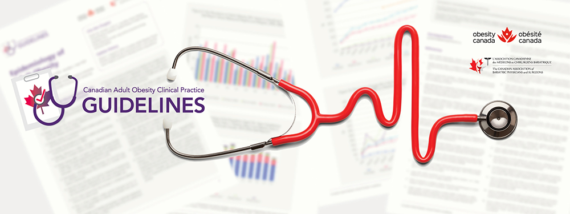
A Patient-Centered Approach to Obesity Care: Can it Be the New Normal?
by Ian Patton, PhD, Director of Advocacy and Public Engagement at Obesity Canada
After almost three years of work, Obesity Canada and the Canadian Association of Bariatric Physicians and Surgeons have released new patient-centered Adult Obesity Clinical Practice Guidelines (CPG’s). More than 60 expert healthcare providers, researchers and people with obesity built consensus on best practices and reviewed over 500,000 peer-reviewed papers published in scientific journals to identify the best evidence for a long list of topics related to obesity management.
Traditionally, CPG’s are tools written for doctors, and they provide a road map to refer to as they manage disease in their patients. While our new guidelines also share that primary audience, we have taken some significant steps to ensure our guidelines are applicable to and supportive of people living with obesity. Most importantly, we made sure that these voices and experiences were represented throughout the CPG development process. The authors then identified the ideal patient journey, which informed every aspect of the guidelines.
5 Steps in the Patient Journey: Ask, Assess, Advise, Agree, Assist
- Recognition of obesity as a chronic disease by healthcare providers, who should ask the patient permission to offer advice and help treat this disease in an unbiased manner.
- Assessment of an individual living with obesity, using appropriate measurements, and identifying the root causes, complications and barriers to obesity treatment.
- Discussion of the core treatment options (medical nutrition therapy and physical activity) and adjunctive therapies that may be required, including behavioral/psychological, pharmacologic and surgical interventions.
- Agreement with the person living with obesity regarding goals of therapy, focusing mainly on the value that the person derives from health-based interventions.
- Engagement by healthcare providers with the person with obesity in continued follow-up and reassessments, and encouragement of advocacy to improve care for this chronic disease.
Addressing Weight Bias
The CPG’s also stress that effective obesity management cannot take place without first addressing weight bias and discrimination in the healthcare system. We know weight bias impacts the quality of obesity care and the degree to which people can access it when needed.
We also know that individuals living with obesity experience weight bias in such a way that discourages us from seeking out help when we need it. Any attempt to provide best practices without addressing this issue would be useless. This is why we made weight bias a key chapter, as well as encouraging all authors to apply a weight bias lens to their work.
The weight bias chapter of the CPG’s highlights the fact that weight bias is systemic. Weight bias is everywhere! We basically live in a society that is obsessed with weight and weight-loss. Realizing that we all have weight bias, the guidelines make evidence-informed recommendations to reduce it. The guidelines also highlight the impact of internalized weight bias, which is weight bias against ourselves that makes us believe we deserve the mistreatment we get from healthcare professionals and society. Internalized weight bias is harmful to our health and can impact our disease management efforts.
Defining Obesity
Another highlight is our definition of obesity. In most research, obesity is simply a product of Body Mass Index (BMI). However, we know BMI is not an appropriate measure of health for individuals and is not an appropriate assessment of obesity, either. Rather, it is merely an indication of size. Our guidelines define obesity as a “prevalent, complex, progressive, and relapsing chronic disease characterized by abnormal or excessive body fat (adiposity) that impairs health.” The key phrase here is “impairs health.” Not everyone who lives in a larger body has impaired health, and therefore not everyone who lives in a larger body has obesity and requires treatment. It’s a small but important distinction.
Why Do These Guidelines Matter?
The answer is simple: the vast majority of healthcare providers receive little to no training in obesity management, yet we all still expect our providers to be able to help us. The guidelines will provide direction on what the current evidence and consensus says they should be doing to manage obesity with their patients. It’s a one-stop-shop, easy-to-use and credible source.
However, the CPG’s are also much more than that. As a patient advocate, the guidelines are now one of our most powerful advocacy tools. We can use them to help individuals advocate for themselves and access the care they need. When a doctor refuses to consider a treatment or pushes their patient to simply “eat less and move more,” we can push back and say, “You are obligated to run an evidence-based practice, and what you are suggesting is not evidence based. Here is what you need to know.” We can use the CPG’s to increase interest in obesity specialization among health professionals, something Canada (and most countries) desperately needs. We can also point to the guidelines as our north star when advocating to healthcare policy makers when they ask, “What can we do?”
The greatest impact of the new CPG’s for patients is in the bottom-up approach to spreading this knowledge. Rather than simply giving this to doctors and hoping they implement it, patients themselves will have the tools and resources to demand better care. Ideally, the guidelines will support a groundswell of individuals living with obesity who understand their disease better, empowering them to recognize they deserve fair and dignified treatment.
About the Author:
Ian Patton, PhD, is Obesity Canada’s Director of Advocacy and Public Engagement. You can read more about the CPG’s at www.obesitycanada.ca/guidelines. Each of the chapters contains plain language key messages for people living with obesity. A summary article of the guidelines is published in the Canadian Medical Association Journal.
